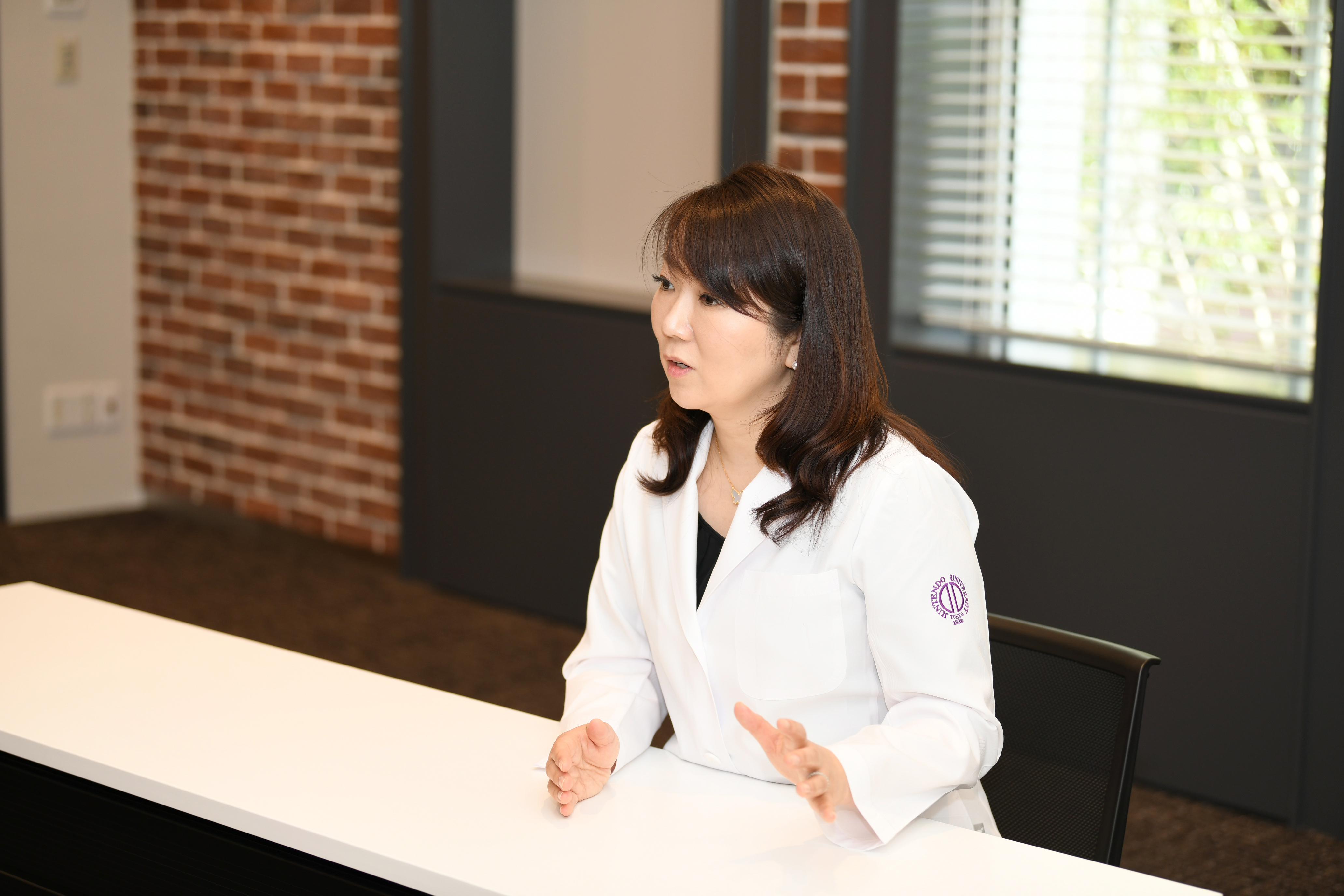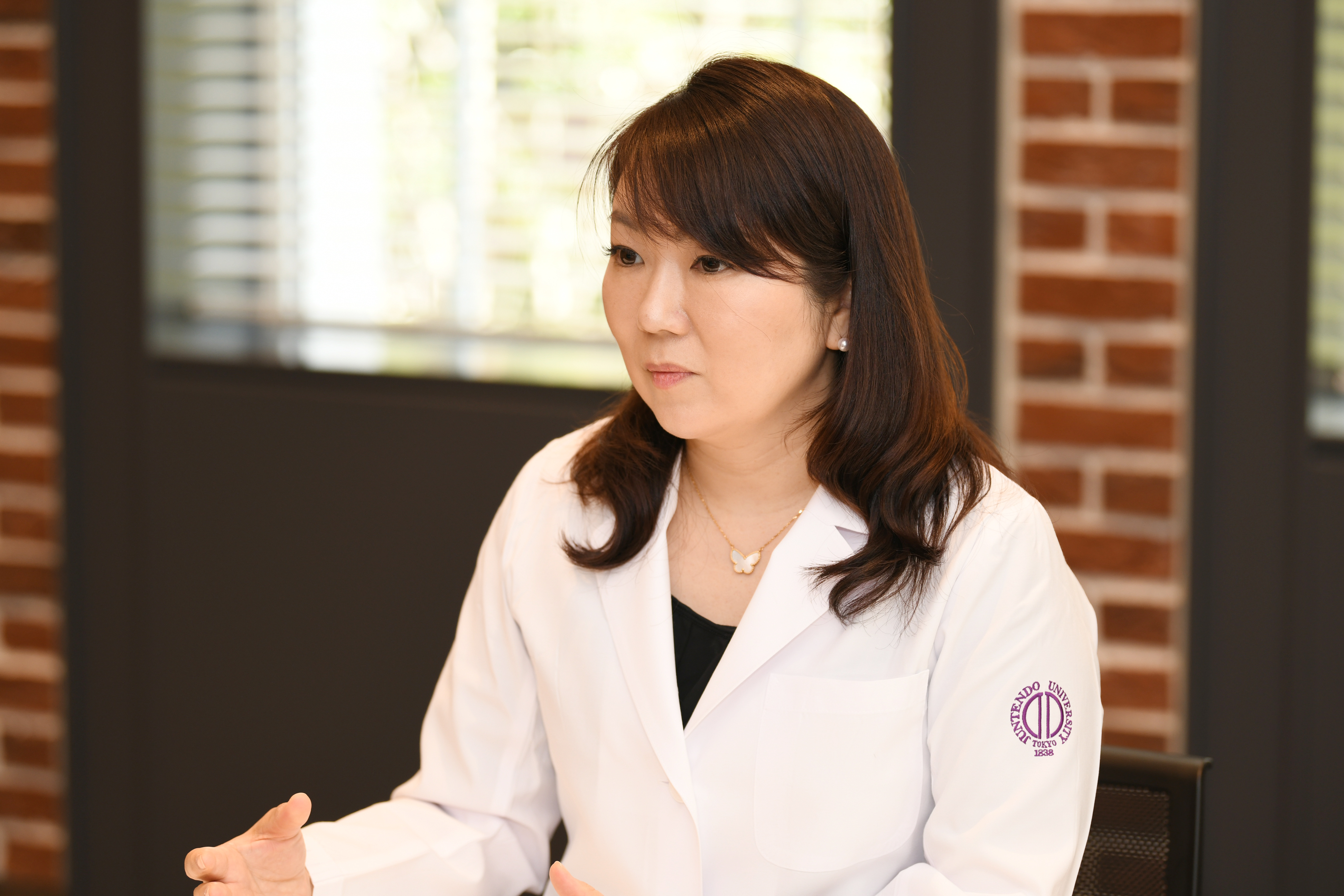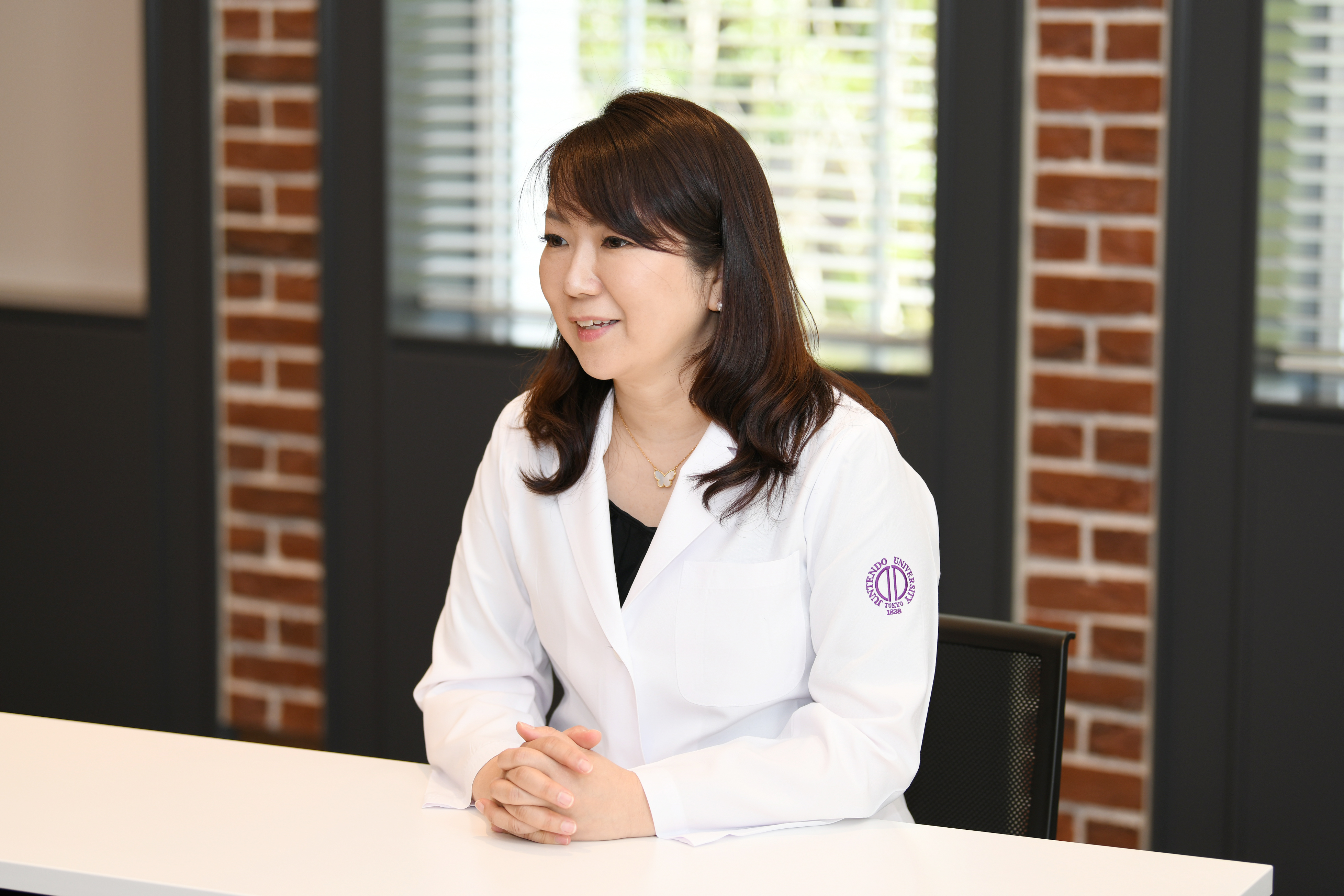May. 24, Mon, 2021
Topics
>RESEARCH
Revascularization therapy to protect the lives and feet of patients
In lower limb ischemia, which results from occlusion of the blood vessels in the feet, ischemic tissue may become necrotic, requiring amputation. Dr Rika Tanaka, a plastic surgeon who has been involved in vascular regeneration research for many years
to treat ischemic diseases with no effective treatment currently, has developed a vascular regenerative cell therapy using stem cells that differentiate into blood vessels. While conducting further research, we are continuing to take on various challenges
toward the development of new treatments and drugs, such as discovering new cells called ReMa cells. This research is expected to expand the possibilities of treatment for ischemic diseases, such as myocardial infarction and cerebral infarction, and has
been adopted by the Japan Science and Technology Agency as a “creative research support project.”
Leg ischemia—in which the blood vessels in the feet are blocked and blood flow is poor—is painful, and if the disease progresses to gangrene, the foot must be amputated. Failing to amputate can put the patient at risk of life-threatening sepsis. I have specialized in treating foot diseases as a plastic surgeon, but I have seen many patients who have been forced to amputate their feet due to advanced ischemic ulcers of the lower limbs.
 There are various diseases caused by ischemia, such as cerebral infarction, if occlusion of blood vessels occurs in the brain, and myocardial infarction if it occurs in the heart, not limited to lower limb ischemia. Many of the causes are diabetes and
arteriosclerosis. All are serious diseases that can have life-threatening prognoses, but currently the only available treatments are those that employ stents or drugs to widen blood vessels. Moreover, only large blood vessels can be treated; it is impossible
to treat the microvessels that supply the muscles of the feet.
There are various diseases caused by ischemia, such as cerebral infarction, if occlusion of blood vessels occurs in the brain, and myocardial infarction if it occurs in the heart, not limited to lower limb ischemia. Many of the causes are diabetes and
arteriosclerosis. All are serious diseases that can have life-threatening prognoses, but currently the only available treatments are those that employ stents or drugs to widen blood vessels. Moreover, only large blood vessels can be treated; it is impossible
to treat the microvessels that supply the muscles of the feet.

Having started a company, as we take another look at our research work from the perspective of a business professional, several areas for improvement stand out. For example, aspects obvious enough to be a fundamental part of business were lacking in our work, such as market analysis and cost awareness. No matter how excellent our research results are, it is not possible to continue the business if it is too costly to lead to a return and, consequently, will not benefit the patient.
Long-term basic research that will eventually lead to discoveries that can save many patients is very important, and it is natural for such work to take a lot of time and money. In all cases, the goal of saving patients remains unchanged. However, I decided that if my first priority is saving the patients I see daily, as soon as possible, I should focus on research and development work that aims to rapidly achieve practical applications.


Dr. Rika Tanaka
Dr. Tanaka graduated from Tokai University School of Medicine in 2002. From the Tokai School of Medicine’s Graduate Department of Plastic Surgery, she went to New York University in the United States to study at the Department of Plastic Surgery in 2006. In 2007, she received a PhD from the Tokai University Graduate School of Medicine. After working as an Assistant Professor of Plastic Surgery at the Tokai University School of Medicine and at the Juntendo University School of Medicine, she entered her current position as an Associate Professor of Plastic Surgery at Juntendo University School of Medicine. She is also the Director of the Juntendo Clinic’s Podiatry Center and the Director of the Laboratory for the Practical Application of Regenerative Medicines to Intractable Diseases at the Research Center for Intractable Diseases. Her clinical specialties include wound healing (intractable ulcers), regenerative medicine, foot care, laser treatment (birthmarks/cosmetic treatments), scar keloids, wound surgery, and cosmetic surgery. Her research specialties include revascularization, vascular stem cell biology, wound healing, applied research, and cell therapy, among others.
Ischemic disease can lead to foot amputation
Our blood vessels are the largest organ system in our bodies. We have around 10,000 km of vasculature inside us, enough to circle the Earth two-and-a-half times. Blood passes through blood vessels throughout the body, from the top of the head to the toes of the feet, to maintain life by carrying oxygen and nutrients. Blood flow is essential for each cell and tissue, but if blood circulation deteriorates and ischemia develops, the maintenance of that tissue becomes difficult, and the patient’s life can even be in jeopardy.Leg ischemia—in which the blood vessels in the feet are blocked and blood flow is poor—is painful, and if the disease progresses to gangrene, the foot must be amputated. Failing to amputate can put the patient at risk of life-threatening sepsis. I have specialized in treating foot diseases as a plastic surgeon, but I have seen many patients who have been forced to amputate their feet due to advanced ischemic ulcers of the lower limbs.

Development of cell-based therapies for microvessels
I have been interested in tissue regeneration and reconstruction since I became a medical student, when I chose the path of plastic surgery out of a desire to work to surgically reconstruct lost functions and tissues. When I was a fifth-year medical student,
I thought, “Could I be able to treat a patient’s lost function using the new technology of regenerative medicine?”, then I began researching regenerative medicine at a graduate school. Since then, as plastic surgeons, we have been working on the study
of revascularization therapy while treating many patients.
A breakthrough in research was the establishment of a culture method that allowed us to grow vascular stem cells outside the body. Revascularization therapies have been developed that involve the transplantation of stem cells (such as CD34-positive cells from the peripheral blood) that have the capacity to differentiate into blood vessels, and these methods have been shown to demonstrate certain therapeutic benefits in patients with arteriosclerosis obliterans and other conditions. However, because very few of these cells are present in the bone marrow or blood, a large amount of bone marrow or blood needs to be extracted, which is a highly invasive treatment for patients. There is also the problem that the function of the harvested cells may be reduced outside the body.
To resolve these issues, we developed a culture method called serum-free ex vivo culture amplification (Quality and Quantity Culture: QQ), which amplifies the number of cells with high revascularization capacity from small amounts of blood in a short period of time. It is an extremely convenient method: we remove mononuclear cells (MNCs) from 200 mL of peripheral blood taken from a patient and culture them for about 1 week. This method does not requiring hospitalization and is quite cost-effective. When MNC-QQ cells obtained from this procedure were injected into the periphery of affected areas, revascularization occurred, resulting in better blood circulation and improved patient condition. Since 2015, clinical research on vascular regenerative cell therapies that use these MNC-QQ cells has been underway, and we plan to proceed with further cell improvement studies in the future.
A breakthrough in research was the establishment of a culture method that allowed us to grow vascular stem cells outside the body. Revascularization therapies have been developed that involve the transplantation of stem cells (such as CD34-positive cells from the peripheral blood) that have the capacity to differentiate into blood vessels, and these methods have been shown to demonstrate certain therapeutic benefits in patients with arteriosclerosis obliterans and other conditions. However, because very few of these cells are present in the bone marrow or blood, a large amount of bone marrow or blood needs to be extracted, which is a highly invasive treatment for patients. There is also the problem that the function of the harvested cells may be reduced outside the body.
To resolve these issues, we developed a culture method called serum-free ex vivo culture amplification (Quality and Quantity Culture: QQ), which amplifies the number of cells with high revascularization capacity from small amounts of blood in a short period of time. It is an extremely convenient method: we remove mononuclear cells (MNCs) from 200 mL of peripheral blood taken from a patient and culture them for about 1 week. This method does not requiring hospitalization and is quite cost-effective. When MNC-QQ cells obtained from this procedure were injected into the periphery of affected areas, revascularization occurred, resulting in better blood circulation and improved patient condition. Since 2015, clinical research on vascular regenerative cell therapies that use these MNC-QQ cells has been underway, and we plan to proceed with further cell improvement studies in the future.
Discovering the unknown “ReMa cells”
As the next step of cell-based therapy using MNC-QQ cells, we have begun to develop new drugs for vascular regeneration. Revascularization therapies that involve the direct injection of agents into affected sites cannot easily be used in conditions that
involve the heart and brain. The therapy itself is also quite invasive, and open-heart surgery is required even for existing cell-based therapies for myocardial infarction that use iPS cell-derived cardiomyocytes. For a long time, I believed that it was
impossible to regenerate the blood vessels by administering therapeutic agents into the blood instead of injecting them directly into affected areas.
However, we discovered a completely new, hitherto unheard-of method capable of achieving this very effect: the use of previously unknown ReMa cells. While their role in the body is still largely unknown, we have been able to determine that ReMa cells, present in small quantities in blood samples, play a key role in revascularization. ReMa cells may also be macrophages, a type of immune cell.
However, we discovered a completely new, hitherto unheard-of method capable of achieving this very effect: the use of previously unknown ReMa cells. While their role in the body is still largely unknown, we have been able to determine that ReMa cells, present in small quantities in blood samples, play a key role in revascularization. ReMa cells may also be macrophages, a type of immune cell.

First worldwide discovery of unknown “ReMa cells”
Towards the realization of new therapies and drugs
We will begin by developing techniques to grow and amplify ReMa cells outside the body.
In the next step, we will work to engineer ReMa cells such that when given by catheterization or infusion, they will migrate through the bloodstream to reach the ischemic tissue and regenerate blood vessels there. If this treatment becomes available, it should allow treatment of ischemic disease all over the body, including areas into which direct injection is impossible.
In addition, we are looking forward to developing drugs that increase the small number of ReMa cells that are normally present in the bloodstream. However, many hurdles remain on the path to this goal, including clarifying the histological properties of ReMa cells; I anticipate that this particular problem is not one that can be solved in the matter of a few years. However, if a minimally invasive, safe, and highly efficient revascularization therapy using ReMa cells can be realized, I believe it will contribute significantly to Japanese healthcare; arteriosclerosis-related diseases are projected to increase as our population ages.
In the next step, we will work to engineer ReMa cells such that when given by catheterization or infusion, they will migrate through the bloodstream to reach the ischemic tissue and regenerate blood vessels there. If this treatment becomes available, it should allow treatment of ischemic disease all over the body, including areas into which direct injection is impossible.
In addition, we are looking forward to developing drugs that increase the small number of ReMa cells that are normally present in the bloodstream. However, many hurdles remain on the path to this goal, including clarifying the histological properties of ReMa cells; I anticipate that this particular problem is not one that can be solved in the matter of a few years. However, if a minimally invasive, safe, and highly efficient revascularization therapy using ReMa cells can be realized, I believe it will contribute significantly to Japanese healthcare; arteriosclerosis-related diseases are projected to increase as our population ages.
Establishing a venture company for practical use
For some time, we in both clinical and research settings have been working to overcome ischemic diseases. In 2019, we established a Juntendo-affiliated venture company, ReEir Co., Ltd., adding a business perspective to our work. This new challenge will help us accelerate practical applications of our work that can deliver the fruits of our labor to actual patients as a real-life treatment.Having started a company, as we take another look at our research work from the perspective of a business professional, several areas for improvement stand out. For example, aspects obvious enough to be a fundamental part of business were lacking in our work, such as market analysis and cost awareness. No matter how excellent our research results are, it is not possible to continue the business if it is too costly to lead to a return and, consequently, will not benefit the patient.
Long-term basic research that will eventually lead to discoveries that can save many patients is very important, and it is natural for such work to take a lot of time and money. In all cases, the goal of saving patients remains unchanged. However, I decided that if my first priority is saving the patients I see daily, as soon as possible, I should focus on research and development work that aims to rapidly achieve practical applications.

Accelerating practical application to deliver research results to patients as real-life treatments
The idea of “wanting to save patients” is the underlying impetus
Recently, I have been constantly switching hats—researcher, clinician, and entrepreneur—and I feel, at times, like my head is spinning. It has gotten to the point where I am reading business books in the bathtub and dreaming about research and projects
at night.
What moves me to go to such lengths are the pain-filled voices of the patients that I have seen in my office. When I tell a patient and their family that their legs must be amputated to save their life, they often plead through tears, saying “I don’t want to amputate my feet. Please, isn’t there a way for me to get better?” And I have no choice but to answer, “I can’t cure it now.” Every time I go through such an interaction, my desire to discover a way to save these patients becomes much more intense. I have no doubt that the cardiologists and neurologists that see patients with heart attacks or strokes everyday hold similar bitter-sweet convictions.
Fortunately, at Juntendo, basic and clinical research are but a stone’s throw from one another, creating an environment in which one can study regenerative medicine research in cooperation with physicians from various medical departments. In addition, we are supported by a structure that promotes research throughout the university, including research administrators who assist with research activities. I believe that “tomorrow will be better than today,” and I would like to steadily achieve results while solving as many problems as I can.
What moves me to go to such lengths are the pain-filled voices of the patients that I have seen in my office. When I tell a patient and their family that their legs must be amputated to save their life, they often plead through tears, saying “I don’t want to amputate my feet. Please, isn’t there a way for me to get better?” And I have no choice but to answer, “I can’t cure it now.” Every time I go through such an interaction, my desire to discover a way to save these patients becomes much more intense. I have no doubt that the cardiologists and neurologists that see patients with heart attacks or strokes everyday hold similar bitter-sweet convictions.
Fortunately, at Juntendo, basic and clinical research are but a stone’s throw from one another, creating an environment in which one can study regenerative medicine research in cooperation with physicians from various medical departments. In addition, we are supported by a structure that promotes research throughout the university, including research administrators who assist with research activities. I believe that “tomorrow will be better than today,” and I would like to steadily achieve results while solving as many problems as I can.

Dr. Rika Tanaka
Professor, Head of Regenerative Medicine at Juntendo University Graduate School of Medicine
Dr. Tanaka graduated from Tokai University School of Medicine in 2002. From the Tokai School of Medicine’s Graduate Department of Plastic Surgery, she went to New York University in the United States to study at the Department of Plastic Surgery in 2006. In 2007, she received a PhD from the Tokai University Graduate School of Medicine. After working as an Assistant Professor of Plastic Surgery at the Tokai University School of Medicine and at the Juntendo University School of Medicine, she entered her current position as an Associate Professor of Plastic Surgery at Juntendo University School of Medicine. She is also the Director of the Juntendo Clinic’s Podiatry Center and the Director of the Laboratory for the Practical Application of Regenerative Medicines to Intractable Diseases at the Research Center for Intractable Diseases. Her clinical specialties include wound healing (intractable ulcers), regenerative medicine, foot care, laser treatment (birthmarks/cosmetic treatments), scar keloids, wound surgery, and cosmetic surgery. Her research specialties include revascularization, vascular stem cell biology, wound healing, applied research, and cell therapy, among others.